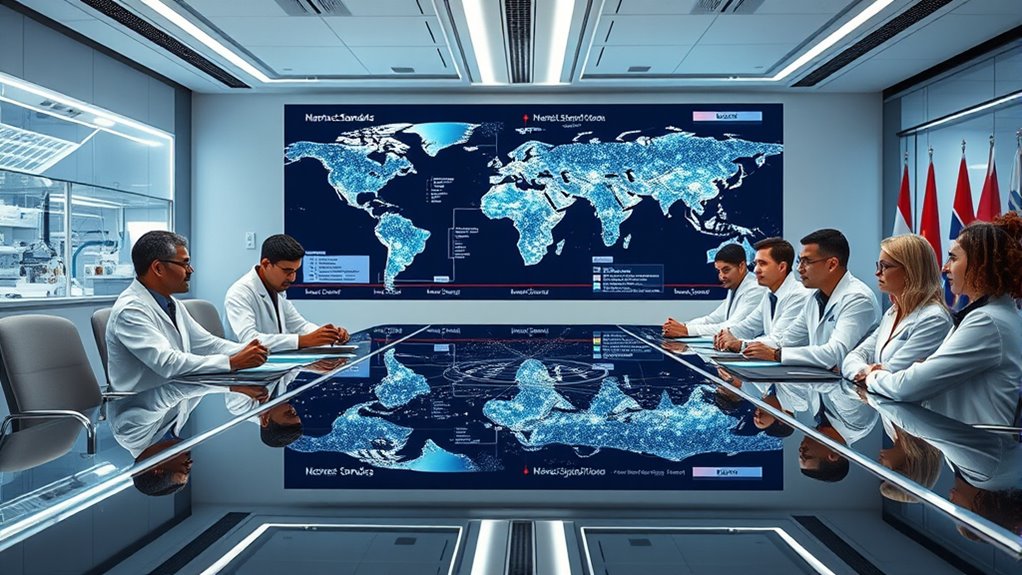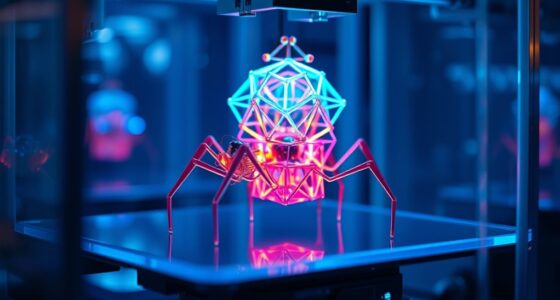Global standards and policies for nanotechnology vary widely, with organizations like ISO, OECD, and the UN promoting safety, ethics, and environmental principles. While some countries have developed extensive regulations, many lack uniform frameworks, creating challenges for international collaboration and safety. Harmonizing these efforts is essential for responsible innovation. If you want to explore how international cooperation and standards can shape the future of nanotech regulation, there’s more to discover ahead.
Key Takeaways
- International organizations like ISO and OECD develop standards for nanomaterials safety, testing, and risk assessment to promote global regulatory harmonization.
- Countries vary in nanotechnology regulations, leading to overlaps and gaps, emphasizing the need for international cooperation and unified frameworks.
- Responsible innovation and ethical considerations are integrated into global policies through UN-led initiatives and stakeholder engagement.
- Standardization efforts focus on terminology, safety protocols, and environmental impact assessments to ensure product quality and safety worldwide.
- Continuous stakeholder collaboration and adaptation of standards are essential for addressing evolving nanotech risks and promoting sustainable development.
Overview of Global Nanotechnology Regulatory Frameworks

Have you ever wondered how different countries regulate nanotechnology? The global landscape varies widely, with some nations establishing exhaustive frameworks, while others remain in early development stages. The United States, for example, relies on agencies like the EPA and FDA to oversee nanomaterials’ safety and applications, focusing on research and risk assessment. The European Union has adopted a precautionary approach, emphasizing precaution and safety standards through regulations such as REACH. Meanwhile, countries like Japan and Canada have developed national strategies that promote innovation while addressing potential risks. Despite these efforts, there’s no unified global regulation, leading to overlaps and gaps. This patchwork of policies reflects differing priorities, resources, and scientific understanding across nations, emphasizing the importance of international cooperation for effective nanotechnology governance. Additionally, regulatory consistency remains a challenge, as harmonized standards could facilitate safer and more efficient development of nanotechnologies worldwide.
Key International Organizations and Their Roles

You should comprehend how international organizations shape nanotechnology regulation by examining their key roles. The UN’s frameworks promote global cooperation, while the OECD provides safety guidelines to guarantee responsible development. Additionally, ISO develops standards that help unify practices across countries, supporting consistent regulation worldwide. Engaging with industry standards ensures that practices remain aligned with global expectations for safety and quality.
UN’s Regulatory Frameworks
The United Nations plays a crucial role in establishing a global regulatory framework for nanotechnology, coordinating efforts among member states to address safety, ethical, and environmental concerns. It provides a platform for dialogue, fosters international collaboration, and develops guidelines to ensure responsible innovation. The UN’s agencies, such as UNEP and UNIDO, work to promote sustainable practices and environmental protection. You’ll find that they:
- Facilitate information sharing on nanotech risks and benefits
- Develop global standards and best practices
- Support capacity-building in developing countries
- Encourage responsible research and innovation
OECD’s Safety Guidelines
Building on the UN’s efforts to establish a global regulatory framework, the Organisation for Economic Co-operation and Development (OECD) has developed its own set of safety guidelines to promote responsible nanotechnology innovation. These guidelines focus on evaluating potential risks related to nanomaterials, including toxicity, environmental impact, and worker safety. They provide a structured approach for testing and analyzing nanomaterials, guaranteeing that innovation does not compromise health or safety. The OECD’s guidelines are designed to be adaptable across countries, encouraging consistent safety practices worldwide. By offering a harmonized framework, they help facilitate international trade and collaboration while minimizing regulatory disparities. Your role as a stakeholder involves familiarizing yourself with these guidelines to ensure compliance and support sustainable nanotechnology development.
ISO Standards Development
International organizations like ISO (International Organization for Standardization) play a crucial role in developing and harmonizing standards for nanotechnology. They bring together experts worldwide to create guidelines that ensure safety, quality, and interoperability. ISO’s focus includes defining terminology, testing methods, and risk assessment procedures, which help industry and regulators align globally. You benefit from these standards by ensuring your nanotech products meet consistent benchmarks, facilitating international trade. Key aspects of ISO’s work include:
- Developing technical specifications for nanoscale materials
- Establishing safety assessment protocols
- Promoting best practices for manufacturing
- Facilitating global cooperation and knowledge sharing
Major National Policies and Legislation

Major national policies and legislation play a crucial role in shaping the development and regulation of nanotechnology. They set legal frameworks that guide research, commercialization, and safety practices. Countries like the United States, China, and the European Union have enacted laws that address nanomaterials’ environmental, health, and safety concerns. These laws often require manufacturers to conduct risk assessments and adhere to reporting standards. Policymakers also allocate funding to support innovation and establish regulatory agencies to oversee nanotech activities. By defining permissible uses and setting licensing procedures, legislation directly influences industry growth and public trust. Staying informed about these policies helps you understand the regulatory landscape and guarantees compliance in your nanotechnology-related projects. Additionally, understanding AI security vulnerabilities is essential for developing safe and trustworthy nanotech applications.
Standards for Safety and Risk Assessment

How do we guarantee that nanotechnology products are safe for both people and the environment? You establish standards for safety and risk assessment by implementing clear guidelines and testing protocols. These standards help identify potential hazards early on, ensuring responsible development. You also rely on scientific data to evaluate toxicity, environmental impact, and exposure levels. Regular monitoring and updated risk assessments keep safety measures current. To maintain consistency across industries and borders, international organizations develop harmonized standards. Key aspects include:
Establishing safety standards and continuous monitoring ensures responsible nanotechnology development worldwide.
- Defining safe exposure limits for nanomaterials
- Standardized testing methods for toxicity
- Environmental impact assessment procedures
- Risk management strategies for various applications
Harmonized standards promote global cooperation and consistency in safety practices. This structured approach helps protect health and ecosystems while enabling innovation.
Challenges in Harmonizing Regulations

You may encounter difficulties in aligning regulations across different regions due to their diverse frameworks. Scientific uncertainty also complicates efforts, as gaps in knowledge make it hard to set consistent standards. These challenges hinder the creation of a unified approach to nanotechnology oversight. Additionally, the rapidly evolving nature of beauty and grooming products and trends adds complexity to developing comprehensive regulations.
Divergent Regulatory Frameworks
Harmonizing regulations across different jurisdictions proves to be a complex challenge due to the diverse approaches governments adopt to oversee nanotechnology. Some nations focus on strict safety standards, while others prioritize innovation and economic growth. This divergence creates obstacles for international cooperation and trade. You might encounter:
- Varying definitions of nanomaterials, leading to inconsistent regulations
- Different testing and safety assessment procedures
- Disparities in licensing and approval processes
- Inconsistent labeling and transparency requirements
These inconsistencies hinder the development of universal standards and complicate compliance for companies operating globally. Without aligning frameworks, efforts to guarantee safety and foster innovation risk fragmentation, making it harder to address potential risks effectively. Overcoming these differences is vital for creating a cohesive, effective global nanotechnology governance system. Additionally, establishing common market research strategies can help nations better understand and align their regulatory priorities.
Scientific Uncertainty Barriers
One of the most significant obstacles to harmonizing nanotechnology regulations is scientific uncertainty surrounding nanomaterials. You face challenges because the properties, behavior, and risks of nanomaterials are not fully understood. Variability in how nanomaterials are produced makes it difficult to establish consistent safety standards. Limited data hampers risk assessments, leading regulators to adopt conservative approaches that may differ globally. This uncertainty causes hesitation among policymakers, slowing the development of unified regulations. You also encounter difficulties in testing and measuring nanomaterials accurately, which affects compliance and enforcement. Without clear scientific consensus, countries struggle to align their policies, risking either overregulation or insufficient safety measures. Overcoming this barrier requires ongoing research, international data sharing, and collaborative efforts to clarify nanomaterial behaviors. Additionally, the variability in how nanomaterials are produced complicates the establishment of standardized testing methods, further hindering regulatory harmonization.
Responsible Innovation and Ethical Considerations

As nanotechnology advances, ensuring responsible innovation becomes essential to address ethical concerns and societal impacts. You need to consider how nanotech applications might affect privacy, safety, and equity. Responsible innovation involves proactive engagement with stakeholders, transparent research practices, and adherence to ethical principles. It’s vital to evaluate potential risks before deployment. You should also foster a culture that values societal well-being alongside technological progress. Keep in mind:
- Engaging diverse perspectives to identify ethical challenges
- Developing clear guidelines for safe research and use
- Promoting transparency in development and funding
- Prioritizing public dialogue and trust-building
- Incorporating safety measures from the development of water parks and hydrotherapy practices to minimize unintended consequences
Environmental Impact and Sustainability Measures

The rapid development of nanotechnology raises important concerns about its environmental footprint, making sustainability measures vital. You need to understand that nanomaterials can pose risks to ecosystems and human health if not properly managed. Implementing eco-design principles helps minimize waste and reduces toxicity from the outset. Recycling and safe disposal of nanomaterials prevent environmental contamination. You should also promote the use of biodegradable or environmentally friendly nanomaterials where possible. Regular environmental assessments are indispensable to monitor potential impacts over time. Encouraging transparency and data sharing among researchers and regulators supports informed decision-making. Ultimately, integrating sustainability into nanotech development ensures that innovation benefits society without compromising the environment. These measures help balance technological progress with ecological responsibility.
Case Studies of Regulatory Approaches

You can see how different regions approach nanotechnology regulation through examples like European Nano Regulations and U.S. oversight strategies. Examining these case studies reveals their unique priorities and methods for balancing innovation with safety. Understanding these approaches helps inform how future policies might adapt across diverse regulatory landscapes. Additionally, adopting standardized safety protocols can facilitate international cooperation and ensure consistent safety measures worldwide.
European Nano Regulations
How have European regulatory approaches shaped the development and safety management of nanotechnology? European policies prioritize precaution, emphasizing safety and environmental protection. They have established clear frameworks to evaluate nanomaterials’ risks before market approval. You’ll find that the European Commission’s approach involves:
- Implementing the REACH regulation to control chemical substances, including nanomaterials
- Requiring extensive safety testing and risk assessments
- Promoting transparency through public databases and reporting
- Encouraging innovation while maintaining safety standards
These measures ensure developers consider health and environmental impacts from the outset. Additionally, integrating sound design techniques into safety communications can enhance public awareness and understanding of nanotechnology risks. By integrating nanotechnology into existing regulatory structures, Europe aims to foster responsible innovation. This proactive stance influences global standards, setting a high bar for safety and accountability across industries.
U.S. Oversight Strategies
In contrast to Europe’s precautionary framework, U.S. oversight strategies for nanotechnology focus on a case-by-case approach that balances innovation with safety. You’ll find agencies like the EPA, FDA, and OSHA leading efforts to regulate nanomaterials based on their specific uses and potential risks. The EPA evaluates environmental impacts, often requesting data from companies before approving products. The FDA oversees nanotech in food, medicine, and cosmetics, ensuring safety without stifling innovation. OSHA sets workplace safety standards for handling nanomaterials, emphasizing worker protection. This pragmatic approach allows flexibility, encouraging development while maintaining oversight. Instead of broad regulations, the U.S. emphasizes targeted assessments, adaptive policies, and collaboration between agencies and industry, aiming to foster innovation without compromising public health or safety.
The Future of International Collaboration

What does the future hold for international collaboration in nanotechnology regulation? It’s poised to become more unified as countries recognize the need for shared standards. Expect increased cooperation through global forums and bilateral agreements that address safety, ethics, and innovation. You’ll see efforts to bridge gaps between developed and emerging nations, fostering a more inclusive approach. Key trends include:
- Harmonizing safety standards to prevent trade barriers
- Sharing research and technological advancements
- Developing adaptable regulatory frameworks
- Building trust through transparent communication
This collaboration aims to balance innovation with risk management, ensuring responsible development worldwide. As nations work together, you’ll notice a shift toward more cohesive policies that support global growth while safeguarding public interests.
Recommendations for Developing Unified Standards

To develop effective unified standards for nanotechnology, you need to prioritize international consensus-building and clear communication channels. Engage stakeholders from various countries early in the process to ensure diverse perspectives are considered. Establish multinational working groups that focus on harmonizing safety, ethical, and technical guidelines. Use existing international organizations, like ISO or OECD, to facilitate standard development and promote widespread adoption. Consistent terminology and measurement methods are essential to avoid confusion and ensure interoperability. Encourage transparency and open dialogue to address concerns and adapt standards as technology evolves. By fostering collaboration and sharing best practices, you can help create a cohesive framework that supports innovation while safeguarding health, safety, and the environment globally.
Frequently Asked Questions
How Do Different Countries Define “Nanotechnology” for Regulatory Purposes?
Different countries define nanotechnology for regulatory purposes based on particle size, typically focusing on materials between 1 and 100 nanometers. Some nations emphasize the unique properties and potential risks of nanomaterials, while others incorporate broader definitions that include specific applications or manufacturing processes. You should check the specific regulatory guidelines in each country, as these definitions influence safety standards, labeling, and approval procedures for nanotechnology products.
What Are the Economic Impacts of Implementing Global Nanotech Standards?
You’ll find that implementing global nanotech standards can boost your economy by fostering innovation, reducing trade barriers, and attracting investments. It streamlines product development, making your industry more competitive worldwide. However, it might also increase costs upfront for compliance and research. Overall, adopting these standards can lead to long-term growth, job creation, and a stronger position in the global market, benefiting your sector and economy over time.
How Are Public Concerns and Societal Values Integrated Into Policies?
Like Pandora’s box, public concerns shape nanotech policies by revealing fears and hopes. You’re encouraged to participate in consultations, share your perspectives, and influence decision-makers. Societal values are integrated through transparent communication, ethical guidelines, and public engagement initiatives. This guarantees policies reflect diverse viewpoints, balancing innovation with safety. Your voice helps steer nanotech development toward responsible progress, respecting societal morals and addressing potential risks before they become uncontrollable.
What Funding Mechanisms Support International Collaboration on Nanotech Safety?
You can access funding through international organizations like the OECD, which provides grants and collaborative projects focused on nanotech safety. Governments also allocate funds via bilateral agreements, joint research initiatives, and grants from agencies such as the European Commission or NIH. Public-private partnerships and foundations may contribute as well, fostering cross-border collaboration. These mechanisms help pool resources, share expertise, and promote the development of all-encompassing safety standards worldwide.
How Will Emerging Nanotech Applications Influence Future Regulations?
Imagine a tiny ship maneuvering uncharted waters—that’s how emerging nanotech applications will shape future regulations. As these innovations grow, you’ll likely see more adaptive policies designed to keep pace with rapid advancements, much like a captain adjusting course to new horizons. Data shows that regulatory frameworks are evolving swiftly, ensuring safety without stifling innovation. You’ll need to stay informed, because future rules will directly influence how you develop, use, and regulate nanotech products.
Conclusion
So, after all this talk about global standards, you’d think everyone’s on the same page. But alas, nations still cling to their own rules like a toddler to a favorite toy. Maybe one day, we’ll finally see a unified nanotech regulation—until then, enjoy the chaos. Because who needs consistency when you can have a wild, unpredictable regulatory playground? Cheers to the future of international collaboration—if only it weren’t so utopian.









